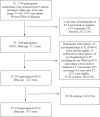Anxiety disorders in adolescents and psychosocial outcomes at age 30
- PMID: 24456837
- PMCID: PMC4028371
- DOI: 10.1016/j.jad.2013.12.033
Anxiety disorders in adolescents and psychosocial outcomes at age 30
Abstract
Background: Anxiety disorders are associated with adverse psychosocial functioning, and are predictive of a wide range of psychiatric disorders in adulthood.
Objective: The present study examined the associations between anxiety disorders during childhood and adolescence and psychosocial outcomes at age 30, and sought to address the extent to which psychopathology after age 19 mediated these relations.
Method: Eight hundred and sixteen participants from a large community sample were interviewed twice during adolescence, at age 24, and at age 30. They completed self-report measures of psychosocial functioning and semi-structured diagnostic interviews during adolescence and young adulthood.
Results: Adolescent anxiety predicted poor total adjustment, poor adjustment at work, poor family relationships, problems with the family unit, less life satisfaction, poor coping skills, and more chronic stress. Adolescent anxiety predicted, substance (SUD), alcohol abuse/dependence (AUD), and anxiety in adulthood. No adult psychopathology mediated the relationship between childhood anxiety disorders and psychosocial outcomes at age 30. Adult, SUD, AUD and anxiety mediated the association between adolescent anxiety and most domains of psychosocial functioning at age 30.
Limitations: The participants are ethically and geographically homogenous, and changes in the diagnostic criteria and the interview schedules across the assessment periods.
Conclusion: Adolescent anxiety, compared to childhood anxiety, is associated with more adverse psychosocial outcomes at age 30. Adolescent anxiety affects negative outcomes at age 30 directly and through adult anxiety, SUD and AUD.
Keywords: Adolescent anxiety; Anxiety disorders; Course of anxiety disorders; Psychosocial impairment.
Copyright © 2014 Elsevier B.V. All rights reserved.
References
-
- Aschenbrand SG, Kendall PC, Webb A, Safford SM, Flannery-Schroeder E. Is childhood separation anxiety disorder a predictor of adult panic disorder and agoraphobia? A seven-year longitudinal study. J Am Acad Child Adolesc Psychiatry. 2003;42:1478–1485. 2003. - PubMed
-
- American Psychiatric Association . Diagnostic and statistical manual of mental disorders. 3rd ed., rev. Author; Washington, DC: 1987.
-
- American Psychiatric Association . Diagnostic and statistical manual of mental disorders. 4th ed., rev. American Psychiatric Association; Washington: 1994.
-
- Andrews FM, Withey SB. Social indicators of well-being: Americans’ perceptions of life quality. Plenum Press; New York: 1976.
-
- Angold A, Costello EJ, Erkanli A. Comorbidity. Child Psychol Psyc. 1999;40:57–87. - PubMed
Publication types
MeSH terms
Grants and funding
LinkOut - more resources
Full Text Sources
Other Literature Sources
Medical


